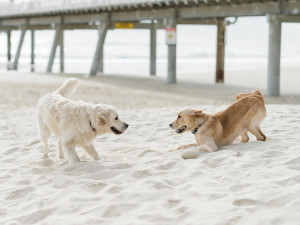A Tail-Wagging Dog Isn’t Always a Happy Dog
This body language is not as simple as you probably think

Share Article
If you were asked to imagine a dog with a wildly wagging tail, you’d probably guess that dog is pretty happy, right? Well, maybe. It’s true that friendly dogs tend to wag their tails, but – prepare for your mind to be blown – that doesn’t mean a wagging tail is a sure sign of friendliness. In fact, lots of dogs wag their tails when they aren’t actually in the best mood, and this misconception can lead people to believe it’s OK to interact with the pup when it actually might not be. Spoiler: tail wags are more complicated than you might think.
The meaning behind the wag
So, what does a tail wag mean? The most accurate interpretation is that the dog is willing to interact. The thing is, ‘interact’ is a very broad term. Friendly dogs who want to interact by greeting, playing or snuggling wag their tails, but so do dogs who want to interact by fighting, bitingopens in a new tab and threatening. The simple observation that a dog is wagging their tail doesn’t give you enough information to determine what kind of interaction the dog has in mind.

littleKin™ is Kinship’s home just for puppy and kitten parents. Bop over to check out expert advice, new pet tools, and special deals—all curated for your newest family member.
opens in a new tabDon’t panic, though: observing details of the tail-wagging behaviour allows you to make a much better prediction about what’s behind it (no pun intended). To determine if that tail wag is a friendly one, pay attention to how much of the tail and the body are involved in the wag, how fast and how far the tail is wagging, and how much tension is in the tail.
Body language
Generally, the more the wag encompasses the whole body, the friendlier the dog’s intentions. The full-body wag that extends from the shoulders through the belly to the hips and the tail is the classic, friendly tail wag. An active tail wag that gets the hips swinging is also a likely sign of high sociability. (Bonus: these wags can even be recognised in dogs who have no tails to speak of!) When just the tail moves, the wag may or may not have anything to do with being sociable. When only the tip of the tail moves, the dog is most likely not feeling friendly.
Speed
Another way that dogs give us information about what the wag means is speed. Fast wags that move through a big arc are associated with friendliness, while a slow wag that doesn’t move the tail much is a sign of an absence of friendliness. Sometimes, dogs who are a little nervousopens in a new tab, or maybe reserved, wag slowly, which simply shows some hesitancy about interacting. In other cases, a slow tail wag can signify aggressive tendencies.
Tension
Tension is another revealing attribute: a stiff tail wag is not a good sign. The more relaxed a tail is while it is wagging, the more likely it is that the dog is friendly. A flexible, fluid motion in the tail suggests friendliness; a rigid tail does not.
Rotation
Sometimes a dog wags their tail in a rotating motion that starts from the base, with the tip of the tail tracing a broad circle. Known as a ‘circle wagopens in a new tab’, it is one of the positive signals that experienced dog handlers watch for when evaluating dogs because it is so strongly associated with dogs who are in a friendly mood. Also called the ‘propeller wag’ or ‘helicopter tail’, this tail motion is particularly common in dogs who are greeting a close friend, especially after a long absence.
To sum up, the friendliest type of tail wag is the full-body wag with a rapidly moving, flexible tail swinging widely from side to side. In contrast, the least friendly tail wag – and the one of most concern in terms of potential aggression – is the slow twitch of only the tip on an otherwise unmoving, rigid tail attached to an equally stiff body. This unfriendly tail wag is frequently displayed prior to a bite.
A wagging tail indicates an interest in interacting, but the details of the wag reveal its meaning. Pay careful attention to the specifics of a tail wag to discern its significance. Friendly dogs want to interact and their tail wags show that. But, remember, there are unfriendly ways of interacting, including biting, and dogs with those intentions also wag their tails.

Karen B. London, PhD, CAAB, CPDT-KA
Karen B. London, Ph.D., is a Certified Applied Animal Behaviorist and Certified Professional Dog Trainer who specializes in working with dogs with serious behavioral issues, including aggression, and has also trained other animals including cats, birds, snakes, and insects. She writes the animal column for the Arizona Daily Sun and is an Adjunct Professor in the Department of Biological Sciences at Northern Arizona University. She is the author of six books about training and behavior, including her most recent, Treat Everyone Like a Dog: How a Dog Trainer’s World View Can Improve Your Lifeopens in a new tab.
Related articles
![Dog in the sand smiling at the camera]() opens in a new tab
opens in a new tabWhat Are You Smiling At?
There’s a big difference between a dog smiling and showing their teeth
![Russian Toy Terrier with ears back]() opens in a new tab
opens in a new tab9 Reasons Why Dogs Put Their Ears Back
Here‘s how your dog’s ears can clue you into how they’re feeling
- opens in a new tab
After a Fight, Do Dogs Forgive?
Studies have shown why some dogs choose to be friendly after a fight
![Adorable dog sitting on a rug next to some boots scooting]() opens in a new tab
opens in a new tabThe Post-Poo Scoot: Weird Things Dogs Do, Explained
Dog trainer Emma Bowdrey helps explain this common canine behaviour






